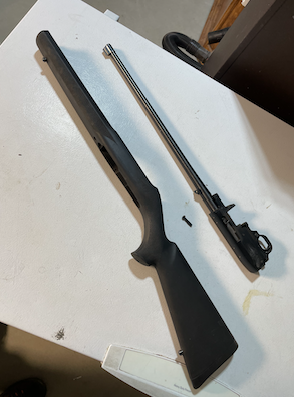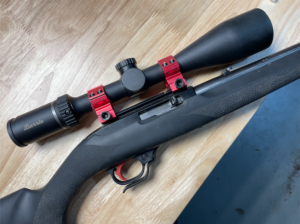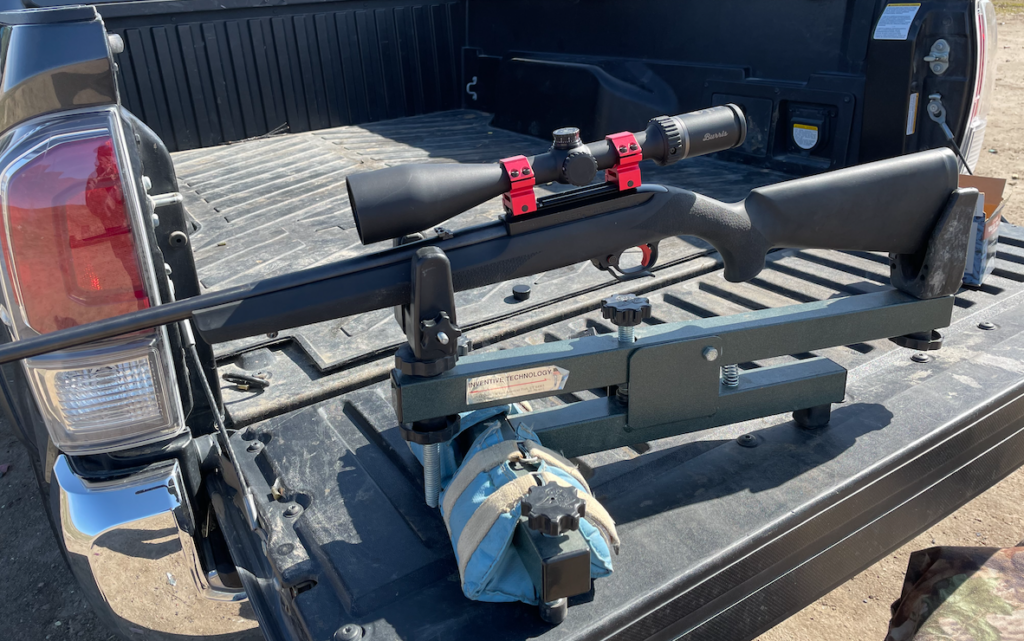
BY TIM E. HOVEY
I would venture a guess that anyone that has a gun safe or has been in the hunting game for a while likely has this popular firearm in their collection. With its lightweight construction (the entire gun comes in at a mere five pounds), and features like the now-famous 10-shot rotary magazine, this compact rifle, was billed as the perfect starter gun for youths to learn marksmanship with. This rifle is the iconic Ruger 10/22.
With an original asking price of $54.50, the Ruger 10/22 was first introduced in the mid 1960s. At that time, the original standard stock was switched to more plain birch or maple. The barrel length of the original stock Ruger 10/22 was 18.5 inches, and that length remains the standard for the lightweight rifle. With over six million of the legendary rifles sold since its debut in 1964, it is a good bet that if you’ve ever plinked with a .22 caliber, you’ve held one of the finest rimfire rifles ever designed.

In 1981, I turned 18 years old, the legal age at the time in California to purchase my own firearms. I can’t exactly remember where I purchased the rifle, but my very first firearm I purchased for myself was the Ruger 10/22. After hunting with the open sights for a season, I eventually topped the rifle with a Weaver 3-9 variable scope. From that day on, if I was in the field hunting small game, I was using the Ruger 10/22.
I’m a little embarrassed to admit that in the decade that followed the 10/22 purchase, I ran thousands and thousands of rounds of .22 ammo through the Ruger without ever cleaning it. When I wanted to head out to hunt, I’d grab the Ruger, two magazines, an extra box or two of ammo and just go. In all that time, she never let me down.
As is often the case, I began to accumulate more firearms as I got older. The Ruger began to spend a lot of time in the safe starting in the early ‘90s. Once I picked up a couple of .17 HMR rifles, the Ruger 10/22 saw very little use.
Earlier this year, I was rearranging one of my gun safes and came upon the Ruger 10/22 in the back. At some point I removed the scope, likely selling it off to fund another project. I was a little surprised to see that the rifle was no longer sporting the standard walnut stock it had come with. I then remembered that during a brief stint using the Ruger to remove non-native bullfrogs for the California Department of Fish and Wildlife, I had opted to upgrade the wooden stock to a more durable, rubberized Hogue stock.
I placed the rifle back in the safe and closed it. I thought about all the amazing times I had had toting the little rifle all around the hills of central California during my youth. I thought about the immense after-market upgrades now available for the 10/22 and decided it was time to bring the Ruger back to life.

Last year I picked up a Burris Full Field E1 scope in 6.5 – 20 X 50. I really had no plans for the optics, and it sat in the box for almost a year before I decided to mount it on the Ruger.
Before the rebuild, I completely tore down the rifle and examined all the parts. It was painfully clear that my cleaning neglect had taken its toll. The trigger and bolt assembly were caked with burned powder, dirt, and all the parts were worn. It was time for a change.
I did a search and found a complete drop in trigger assembly from Ruger RED BX. The assembly was a perfect match for the Ruger 10/22. The best part was that the new drop-in replacement had a red anodized trigger that just looked cool.
I picked up a set of updated scope mounting plates and keeping with the black and red theme, I ordered a set of medium rise, heavy duty Weaver, one-inch, red aluminum scope rings. Last on the list was a Timber Creek magazine release in black. Things were looking good for the 10/22.
After waiting a week for parts, I assembled the new version of the Ruger 10/22. After mounting the scope, I loaded up to sight the rifle in. On the drive out, I tried to remember the last time I had the rifle out to shoot. I couldn’t.
It took me a bit longer to dial in the scope, but I soon had the little rifle shooting 1- to 2-inch groups at 75 yards. For me, this was well within the accuracy capability of the little rimfire rifle.
I spent the rest of the afternoon hunting small ground squirrels with the Ruger. The new trigger assembly was smooth, and the trigger broke perfectly. The rebuild on the rifle was a fun project and very easy to do. There are hundreds of upgrade parts for the Ruger 10/22, all available online.
If you speak to any hunter that has accumulated firearms over a lifetime of shooting, they will likely tell you a story about each rifle they have. It’s human nature to attach an emotion to objects that we’ve carried on adventures. I’m no different. The little Ruger was my first rimfire rifle and has been on hundreds of special, early hunts with me. It holds a special place in my early hunting legacy. And even though it looks a bit different and cool as heck with the new splashes of red, our history together remains unchanged.




